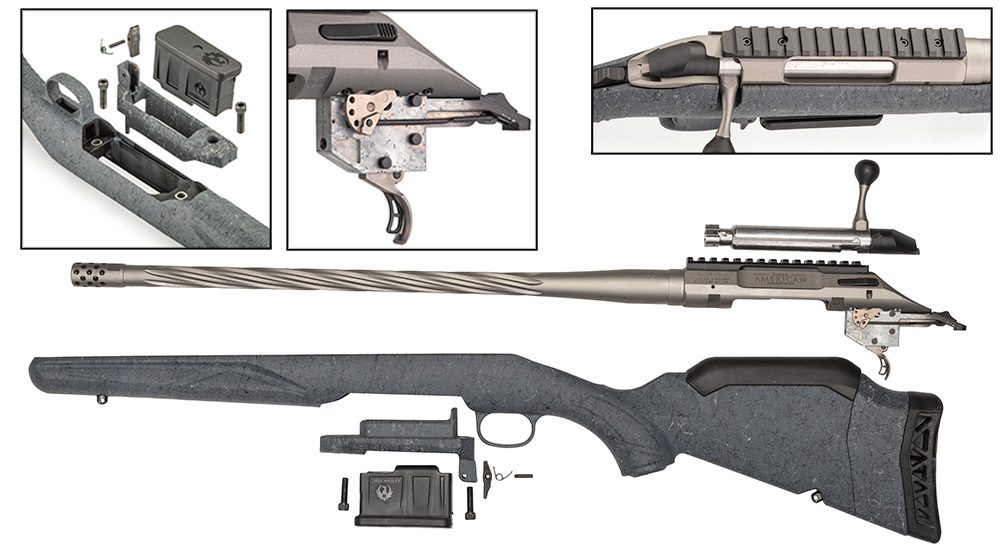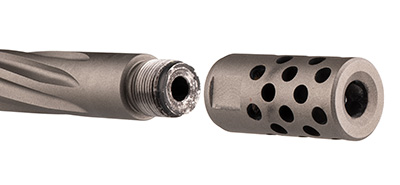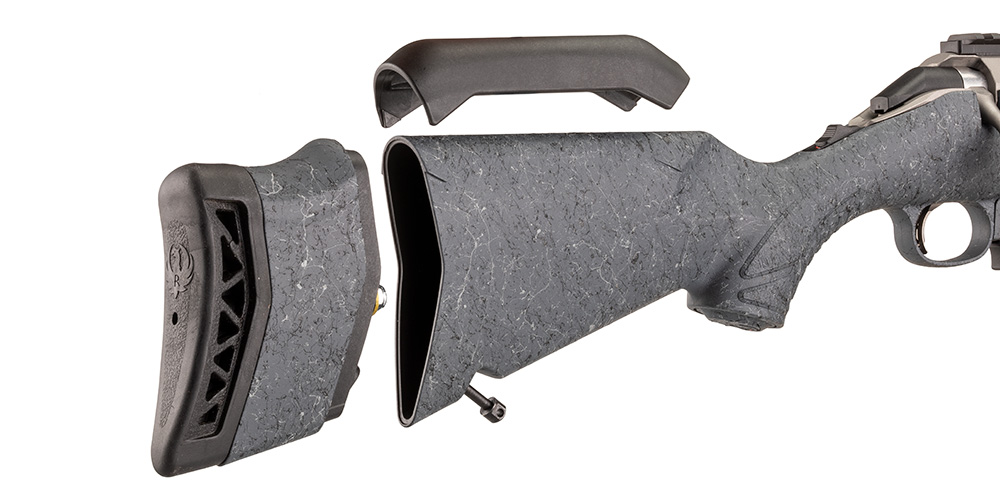
"New things are always better than old things.”
That maxim, attributed to the late artist and film director Andy Warhol, is faithfully embraced by businesses unafraid of critiquing their efficacious products in the unending search for something better. Sturm, Ruger, & Co. is one such firm. In the past three-quarters of a century, it has unveiled a litany of firearms that have not only withstood the test of time but have sold in overwhelming numbers. In long guns alone, there is the 10/22, M77, No. 1 and Mini-14 (Mini Thirty) that, in sum, are measured in millions of units. And yet, none of these well-liked arms went unchanged; myriad variations of each model exist, while shortcomings, whether real or perceived, have been addressed, too.
It makes sense, then, that the company would eventually cast a discerning eye toward its meat-and-potatoes—and outrageously popular—American Rifle series, which debuted in 2012. According to Mark Gurney, director of innovation for Ruger, “The American Rifle was successful, but that doesn’t mean there wasn’t room for improvement.” As such, for 2024, Ruger unveiled the American Rifle Generation II series as “The Next Generation of America’s Favorite Hunting Rifle.” So, how do Generation II models differ from the original American rifles? Read on.
Compare & Contrast
As a current owner of two American Ranch rifles (.300 Blackout and .450 Bushmaster) and having previously owned a Standard version in .30-’06 Sprg., I was both overwhelmed and ecstatic—mostly the latter—by the enormity of the changes between the original and Generation II series. Perhaps the most notable upgrades involve the stock. Other than variants with Go Wild camouflage, the barreled actions of American Rifles are nestled into simple synthetic stocks of a single color. Serviceable sure, but aesthetically pleasing they aren’t. What’s more, minimal consideration was levied to combating the inherent slickness of the material. There is integral texturing on raised and lowered sections at the pistol grip and fore-end, respectively, but it’s insufficient for the task. Fortunately, this was addressed in the Generation II guns. The Generation II stock exudes modernity—particularly visually. On the Standard version, the dark gray synthetic stock has black and light gray splatter, which also aids purchase regardless of where the rifle is grasped. The Gen II Ranch has a flat dark earth (FDE) stock with black splatter, while the new Predator combines a green stock with a splash of black and bronze. The color combinations are outstanding. Further aiding purchase are raised, textured panels and ribs on the pistol grip, which swells distinctively, and the panels are also on the recessed fore-end. Interestingly, whereas the fore-end on the original was thicker on the lower portion and thinner on top, Generation II models have this reversed. Additionally, the thinnest portion, when combined with an unchanged upper width, results in a channel that prevents fingers from slipping atop onto the barrel. In the hands, the difference in feel is significant.
The stocks of Generation II rifles enable the user to adjust fit. For instance, there is a well-blended spacer that can be removed to shorten the length of pull from 13¾" to 12", thereby enabling a single rifle to fit a larger segment of the population and/or grow with the shooter. The rifle is also shipped with the removable “low” comb, or cheekpiece, installed, which adds 1/2" of height for when using a magnified optic. It creates a Monte Carlo-like stock. “Medium” and “high” combs are available for purchase from Ruger and add 5/8" and 3/4", respectively. Without the comb installed, the stock is optimal for use with reflex-style sights and other low-mounted devices. Why did Ruger adopt this design? “A majority of our engineers have gone through long-range-shooting classes at FTW Ranch,” Gurney said. “We’ve all learned how a proper cheek weld, which aligns the shooter’s eye directly behind the scope, is so important.”

The Generation II’s barreled action is held to the stock with two machine screws—one of which, on some models, is accessed by removing the magazine latch. Note the construction of the magazine well and stock (inset, far l.), the Ruger Marksman Adjustable trigger assembly (inset, l.) and the 14-slot Picatinny rail attached to the receiver with four screws (inset, above).
There is a reason that the rear sling swivel stud is angled. Removing the spacer and/or comb involves a unique, yet clever, process. Unlike other rifles (including the original American Rifle), accessing the innards of the buttstock isn’t via the recoil pad; rather, unscrewing the rear sling swivel stud several turns loosens the spacer and permits the user to slide the comb to the rear for removal. This design prevents damage to the pliable, tacky recoil pad. Smart.
As with the originals, second-generation models are fed by detachable-box magazines. The configuration of the stock depends on the cartridge (and thus magazine) that it’ll use. As an example, on the sample Standard rifle, which was chambered in 6.5 mm Creedmoor, there’s a separate magazine-well assembly with a magazine latch immediately forward of the trigger guard. Smaller chamberings, such as .223 Rem., use a push-button-type magazine release. On .450 Bushmaster-chambered rifles, the latch is part of the single-stack magazine itself. One word of note: On the trial rifle, the magazine could only be locked into position with the bolt open (thus eliminating “topping off”) or, when the bolt was closed, by applying pressure on the very rear of the magazine. Anywhere else failed to fully seat it. A pronounced “click” results when the magazine latch is fully engaged, so ideally the task would be performed before entering the intended hunting area. Alternatively, one can hold the latch forward while the magazine is inserted, followed by releasing the lever and toggling the magazine to ensure that it’s secure. Doing so eliminates all noise. Why does configuration matter? Simple: full access to the trigger for adjustment and/or a thorough cleaning. On rifles that use AICS-style magazine wells, there is now a notch that provides direct access to the rear action screw using only a ball-end wrench. Generation I rifles without a notch still require removal of the magazine latch to disassemble the rifle. A tool is provided to aid re-installation of the magazine latch.
The Generation II’s barreled action rests atop two V-shaped bedding blocks, which positively maintains its position and ensures that the barrel remains free-floating. Both are essential to accuracy. Ruger refers to the system as Power Bedding. The blocks engage recesses in the receiver to mitigate movement between it and the stock. The system eliminates the need for a traditional recoil lug.
Beyond the bolt-stop lever, which now projects more prominently and has grooves on the rear to make manipulation easier, little has changed with regard to the receiver. On the left receiver wall, though, is found inscribed, “Ruger American. Mayodan, NC, USA” rather than the “Newport, NH,” on the barrel of my older models. Gurney stated, “The majority of American rifles are built in North Carolina, but some are, and will continue to be, made in New Hampshire.” As an aside, all of Ruger’s ARs (including the SFAR) are built in North Carolina, as are Marlins, LCPs, American Rimfires and SR22 pistols. Attached to the top of the receiver at the factory is a one-piece Picatinny rail—something I always appreciate.

(l.) The Gen II American’s bolt features a full-diameter body with three locking lugs. Note the sliding-plate extractor and the plunger ejector. Also, the bolt knob is replaceable. (r.) A simple lever on the receiver’s left rear is pressed in to allow withdrawal of the bolt assembly.
The tang-mounted safety on the second-gen guns is different than that on their predecessors. The fire control has three positions—fire, safe and safe, locked. In the forward-most “fire” position a single, curved red line is shown. In the “safe” setting, the bolt can be cycled for loading and unloading while the gun’s safety is engaged; this is revealed with a single curved white line. When two curved white lines are displayed, and appear like a disappointing Wi-Fi coverage symbol, the bolt is locked closed. Whilst hunting and/or not taking a shot, “safe, locked” is advisable. The control was a smidge jiggly on the test rifle.
The rifles have Ruger’s Marksman Adjustable trigger, which has an articulating blade within the shoe—a widely used design nowadays. It is user-adjustable from approximately 3 lbs. to about 5 lbs. On the sample rifle, it averaged 4 lbs., 12 ozs. For me, it’s definitely a candidate for tweaking the pull weight. No creep or overtravel was detected.
As with the original American rifles, Generation IIs use one-piece, CNC-machined stainless-steel bolts with three lugs for a 70-degree throw. This provides ample clearance for even larger optics. Extraction is via a sliding plate while a plunger-type ejector clears empties from the gun. However, the bolt handles on the Generation II guns have noticeably less curve and, due to a 5/16x24 TPI thread pattern, the oversized knob can be replaced.
Outside of the stock, the most radical departure for Generation II rifles is the cold-hammer-forged barrel. Whereas manufacturers oftentimes add shallow fluting for appeal, and perhaps claim weight savings, those on the Ruger rifles clearly achieve both. Sure, the deep, spiral flutes appeal to the eyes, but they also reduce weight and will dissipate heat faster. However, reduced mass increases the speed at which the temperature rises as well.

The tang-mounted safety has three positions (l. to r.): “fire,” indicated by a red arc; “safe,” which blocks the trigger but allows the bolt to be racked; and “safe-locked,” which blocks both the trigger and the bolt.
On the 6.5 mm Creedmoor test rifle, the barrel measures 1.16" near the receiver and 0.730" rearward of the radial, 30-port brake. Thanks to 5/8x24 TPI threading at the muzzle, the brake can be replaced with other recoil-, flash- or sound-attenuating devices; other thread patterns include 1/2x28 TPI and 11/16x24 TPI depending on the cartridge. Regardless of chambering, the barrel length remains constant within a line. For example, all Standard rifles have 20" barrels, while those of Ranch rifles are 16.10" and Predator rifles are fitted with 22" barrels.
Lastly, the barreled action (barrel, receiver and bolt handle) is covered with a Cerakote ceramic coating. The result is a durable yet easy-to-maintain finish. On the Standard model the Cerakote color used is Gun Metal Gray; meanwhile, the Ranch is Cobalt and the Predator is Burnt Bronze.

On The Range
To test the sample American Rifle Generation II, I topped it with my ever-dependable Nightforce SHV 4-14X 56 mm riflescope. As an aside, be aware that the screws of the included base should be, at a minimum, double-checked for snugness before heading to the range; applying a thread-locking compound before tightening them is preferable. The screws on the rifle I received were not fully tightened, and thus had the potential to negatively affect accuracy.
Subsequently, I gathered an assortment of high-quality 6.5 mm Creedmoor ammunition. Given its primary purpose as a hunting rifle, I opted to incorporate Hornady Outfitter 120-grain CX and Nosler 140-grain Ballistic Tip Hunting (BTH) loads. For the third ammunition, I cherry-picked Berger’s 140-grain Hybrid Target (HT). Why? To see what could be achieved accuracy-wise when using premium, match-grade ammunition. The results were surprising.
Frankly, “range day” was far from ideal; then again, the days preceding and following it were only marginally better. Thanks, March. While the 55o F temperature and cloudless sky were indeed inviting, the consistent 15-m.p.h. wind and frequent gusts reaching more than double that number weren’t. Providentially, the elevated berms and backstop lining the 100-yard range did much to reduce the impact of the swirling winds.
Supported by a Browning sandbag front rest and a rear rest from a now-defunct firm, the trial rifle produced good accuracy—however, the best accuracy didn’t come from the one you’d expect. Rather, top accuracy was realized when using Nosler’s 140-grain BTH, which generated an average of 0.94" for five consecutive, five-shot groups. The smallest cluster measured 0.70", and three of the five shots bunched within 0.30". This trio was only bested by a triad in the smallest group produced by Hornady’s Outfitter ammunition, which measured 0.27".
Although Hornady’s 120-grain CX ammunition produced the smallest five-shot group, 0.69", it also created the largest, 1.33". For 25 shots the mean was 1.12". Berger was nearly identical in performance, averaging 1.10".
While chronographing the abovementioned loads, a large discrepancy was noted between the factory velocities and those that the MagnetoSpeed Sporter calculated. In fact, a second chronograph, a Garmin Xero C1 Pro, was purchased to confirm the numbers. They were accurate. This can be attributed to the rifle’s 20" barrel, as opposed to the 24" tubes used by ammunition makers; but the disparities were striking. Whereas the Berger, Hornady and Nosler loads have advertised speeds of 2,850 f.p.s., 2,925 f.p.s. and 2,650 f.p.s., respectively, from the Generation II Standard rifle they achieved only 2,698 f.p.s., 2,799 f.p.s. and 2,478 f.p.s.
As was to be expected from a modernized variant of an established firearm, the Generation II rifle functioned flawlessly; during testing it fed, fired, extracted and ejected without issue through nearly a dozen boxes of 6.5 mm Creedmoor ammunition. The only hang-up for me was the trigger, which was too heavy. However, that’s a matter of preference, and it can be adjusted at will. It obviously didn’t adversely affect accuracy.

Unscrewing the rear sling swivel attachment stud several turns allows the user to remove or insert the buttstock spacer and select which cheekpiece to attach.
Lastly, I need to comment further on the American Rifle Generation II’s re-designed stock. In the hands and on the range, the differences are readily apparent. Not only is the newer stock more thoughtfully designed, particularly for use with optics, but it is tactilely and visually superior—especially when paired with the spiral-fluted barrel. Fellow riflemen on the range will take note, too. In fact, during testing, only one shooter I encountered didn’t inquire or comment about the rifle.
Parting Thoughts
You’re probably wondering, “Is there a price difference between the Generation II models and the first-generation guns?” Yes, whereas an American Rifle Standard has a manufacturer’s suggested retail price of $599, that of the Generation II is $729. An original Ranch rifle retails for $669, while the newer version costs $729. Lastly, the elder Predator is $699, while the newer one is … . If you guessed $729, you’re correct. The rifle is comparable to other entry-to-mid-priced hunting rifles but with extras omitted elsewhere. It’s better looking to boot. But both generations will be produced for the foreseeable future, so you can choose the one that meets your tastes and budget.
Obviously, Ruger continues to re-invent and re-invigorate its keystone products, regardless of their initial success, and the American Rifle series is a perfect example of that drive to build on proven success. Given my experiences with the Generation II, there seems little reason to doubt that the American Rifle family will continue to thrive.






































